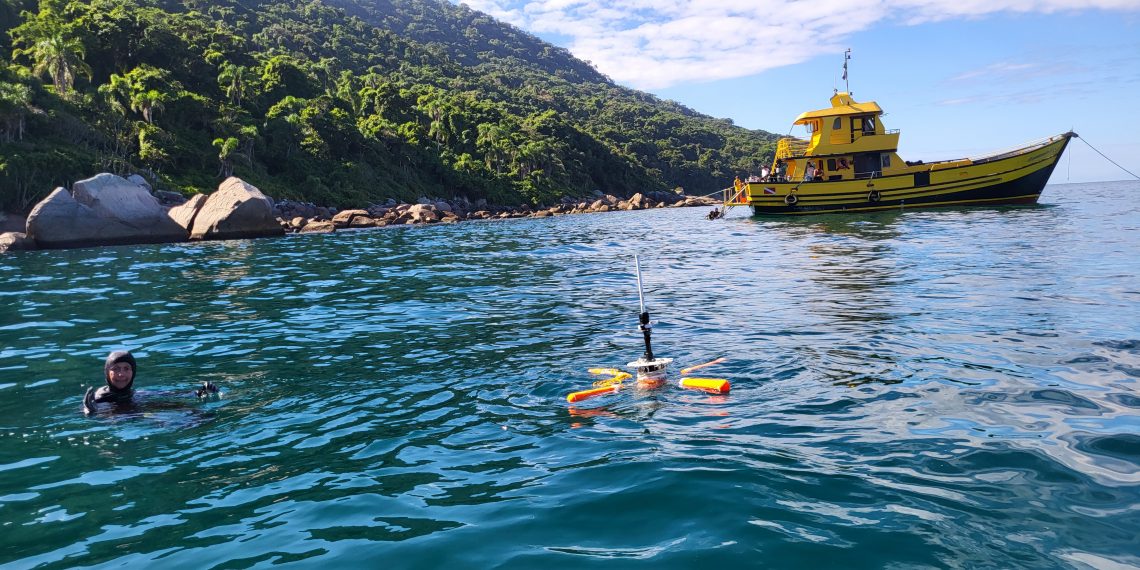The Institute developed a technology to help monitor an invasive species in Brazil. The sun coral – an invasive species that emerged on the Asian continent and has already colonised the entire Gulf of Mexico – appeared in Brazil in the 1980s. Experts suspect that this species came from oil platforms brought from Asia to other continents.
INESC TEC researchers adapted the systems they use in underwater robots to track divers and understand the locations of said corals. The technology features a device that locates underwater objects, a set of buoys that are connected to the GPS and a cylinder with electronics – which is placed on the diver’s back, emitting sound signals to the buoys.
Based on this technology, INESC TEC, together with a Research Laboratory of the Federal University of Santa Catarina (LASUB), in Brazil, carried out a mission to compare the performance of the traditional approach to monitoring this species, using divers, with a method that includes technology to support divers. The results are promising – mainly due to the decrease in the margin of error in the location of the corals.
“There is sun coral in other regions, where it is native and in balance with the ecosystem; however, on the American continent, it is an invasive species. The LASUB researchers are experts in mechanics and are currently developing tools for the removal of these corals in Brazil. In this sense, and following their requirements, we developed a system that included providing divers a cylinder with electronics to carry on their backs, and three buoys in the operating zone, ready to receive the sounds of the cylinders and sent this information, via radio, to the support vessel”, explained Nuno Cruz, researcher at INESC TEC.

In this joint mission carried out by INESC TEC and LASUB, they tried to place receiving buoys in the vicinity of the diving zone. The diver took the emitter, and the operations team could see exactly where the diver was at each moment, and where the corals were located. All this was possible through triangulation, since the buoys determined the relative position of the underwater object and, together with the GPS, were able to provide an accurate location. The researchers from both research centres were on the support boat receiving the information broadcast by the buoys.
Until now, the monitoring was being done only by divers, who found an area with corals, marked it, returned to the surface, took photographs of the surrounding area, and passed them on to the crew of a GPS boat that was nearby and recorded the approximate location. The margin of error could reach several meters.
“With the use of this technology, we realised that it is possible to know quite accurately – a margin of error smaller than 1m – the position where the corals were found and/or removed, which makes it possible to monitor this process with great reliability. We were also able to understand the evolution, or absence, of a certain colony and its evolution through environmental conditions, e.g., sunlight, currents, water temperature, acidification, etc.”, explained Nuno Cruz.
In addition to the lack of precision in visual marking, the traditional approach included other constraints. It was a time-consuming process, since divers had to

come to the surface and mark the position whenever they encountered a coral; it was also inefficient, since much of the air from the diving bottles was used in this marking process, and it was a risk for the divers themselves, in the up and down cycles. Another constraint was the use of GPS or radio signals since they do not work underwater – hence the use of acoustic signals. The device developed by the INESC TEC team, and the triangulation between the GPS and the buoys, allowed to overcome this issue.
“The efficiency levels of this process have increased significantly, since divers can now dedicate all the diving time to the search and identification of the corals. So, in each campaign, they can explore a larger coastline area, safely and accurately. Now, divers mark the places where they find corals through a digital ‘button’ and the support team records said positions”, explained the researcher.
The technology is back in Portugal for more tests by the INESC TEC team. However, and although the sun coral species is the one of biggest concerns, Brazilian researchers are already thinking of new ideas to use the same systems to accurately mark other habitats.
The researcher mentioned in this news piece is associated with INESC TEC and UP-FEUP



 News, current topics, curiosities and so much more about INESC TEC and its community!
News, current topics, curiosities and so much more about INESC TEC and its community!